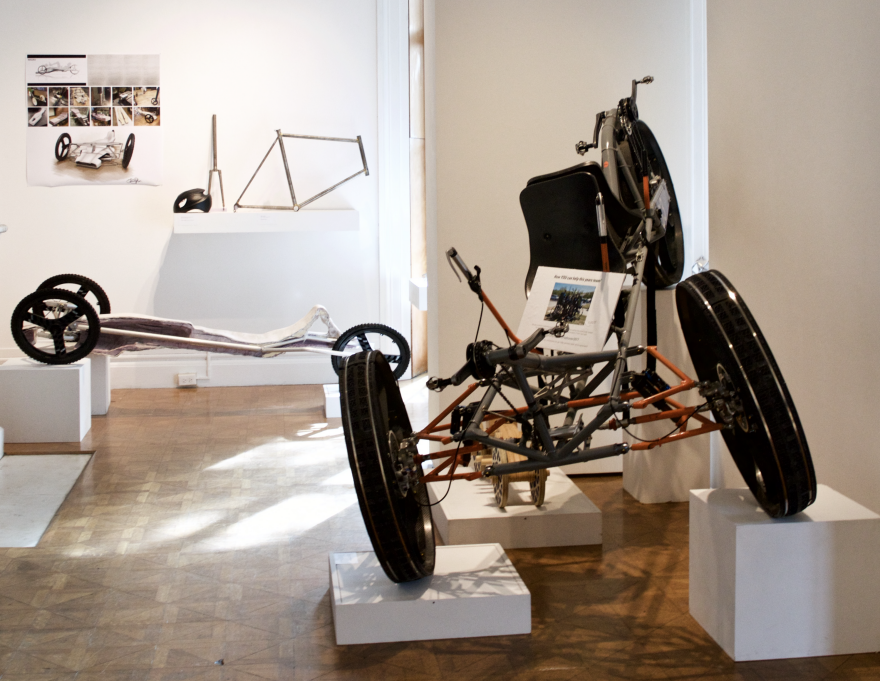#HTE
RISD’s 2016 ID Triennial Demonstrates What’s Behind an Industrial Design Education
Once every three years, each department at Rhode Island School of Design is permitted three weeks to display the products of its curriculum in the school’s historic Woods-Gerry Gallery. Last week marked the opening of RISD’s 2016 Industrial Design Triennial show.

The show was publicized by the distribution of posters featuring an iconic butterfly and anvil image designed by former Industrial Design faculty member and pioneer of universal design, Marc Harrison, whose work exemplified department principles.
Named We Start from Making, the motivations behind the show were to demonstrate just that. As any industrial or product designer knows, the work behind the creation of a product is all too often taken for granted. The triennial not only communicated the steps behind product design, but provided insight into the exercises, and often monotonous assignments, behind an industrial design education.

The first room focused on the department’s Design Principles assignments. With walls covered in the class’s infamous cube drawings and other drawing techniques, the room’s content emphasized the importance of early form development and iterations.

Upon entering the second room, visitors are greeted with the RISD Rover. 2016 marked RISD’s sixth year competing in the NASA Human Exploration Rover Challenge. Over the past six years, the RISD Rover team has acquired almost every trophy, except First Place. One of the most remarkable aspects of RISD’s achievements in a rover competition? None of the team members have any engineering experience. Through a studio course and backed by countless out-of-class hours, the 2016 RISD Rover drove away from the competition, held at the US Space and Rocket Center in Huntsville, Alabama, with two awards: the Featherweight Award, for the design’s ultra-lightweight carbon fiber frame, and Second Place in the College Division.

The common thread tying the room’s content together is the material usage of wood or metal, both required courses by the department.
 Experiments with tin plated steel represent the first assignment in a Metals I class.
Experiments with tin plated steel represent the first assignment in a Metals I class.


 “Chisel Handles” by Grace Kim and Max Reice (ID ‘17)
“Chisel Handles” by Grace Kim and Max Reice (ID ‘17)

Integrated with initial material experiments and beginner assignments, furniture made by students scattered throughout the room demonstrates skills, such as advanced joinery and welding, learned in level two wood and metal classes. In addition to technical skill, the process behind the furniture pieces demonstrates lessons in ergonomics emphasized in many of the department’s advanced furniture studio courses.
 Work by Sarah Crist
Work by Sarah Crist

 “Motorcycle Vest” by Carmen Schweizer (ID '17)
“Motorcycle Vest” by Carmen Schweizer (ID '17)
The third gallery room mainly consisted of wearables and soft goods designed and created by upperclassmen. Each product was presented as a final iteration. From cycling kits to 3D printed shoes to dresses for nursing mothers, each wearable clearly communicated intent and user through each respective final form. Many of the goods were made through the department’s soft goods course, while others were made through a footwear design course.
 “3D Printed Shoe” by Althea Fyffe (ID '17)
“3D Printed Shoe” by Althea Fyffe (ID '17)
 “Breast Feeding Dress” by Christina Chen (MID '17)
“Breast Feeding Dress” by Christina Chen (MID '17)

 Bicycles, back: Matthew Chen, left: William Zhang (ID '19), front: Micah Epstein
Bicycles, back: Matthew Chen, left: William Zhang (ID '19), front: Micah Epstein
In the gallery’s lobby sit four precariously positioned bicycles, partially suspended by fishing wire. Three of the bicycles were made during a summer course—"Tokyo: Bicycle Design and Making"—taught by RISD ID faculty member, Khipra Nichols. The fourth was designed and produced during design studio, “Human Powered Vehicles.”
http://www.core77.com/posts/57561/RISDs-2016-ID-Triennial-Demonstrates-Whats-Behind-an-Industrial-Design-Education
